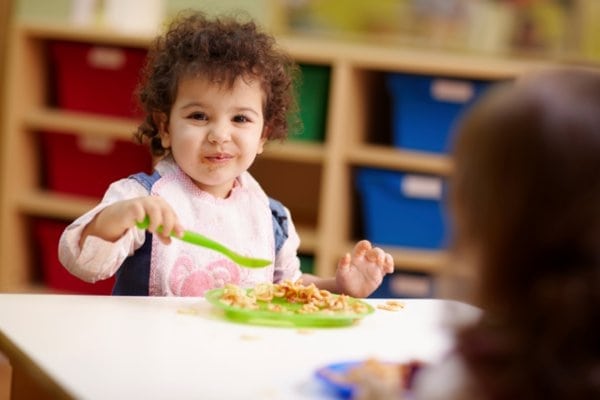Community Market at Bennett Day School
“Ok, fourteen. Let’s go!” her peer shouts and off they head with their teacher, down the hall to the school’s Community Marketplace.
As they arrive at the market they see there are no longer the graham crackers they had yesterday available, but today, apples are the fruit on hand as well as cheese sticks. These apples are very large in size and together, the two classroom shoppers decide it would be best for each Kindergartener to have half an apple and one cheese stick. Together, they work to divide, using their knowledge of skip counting by twos to select seven apples. Once the food has been selected, they must now decide how to transport the snack back to the classroom.
The Community Marketplace at Bennett Day School offers daily real-world challenges to students. During a single day, adults and children alike are faced with problems that are significant to their world, in which they must make a choice. At the Community Market that choice is the outcome of real problem solving. Within a few short minutes, these Kindergarteners are identifying key problems: a child is absent, the snack they assumed would be there is unavailable, the apples are too big for one child to eat, and they need an appropriate mechanism to transport the food to the classroom. Now they must begin the process of idea generating. How can they use the apples but in smaller quantities? How can they carry the apples back and bring the cheese sticks at the same time?
Too often in schools we ask children questions that we already know the answer to. If there is only one solution, children will not be inclined to take risks in their learning. Instead, we must provide them with open ended challenges, that offer both opportunities for success and failure. The two students in the above scenario may decide that they can simply carry the apples in their arms. The teacher welcomes that solution, as she knows there is a great chance of the apples spilling out of their arms and not making it safely into the classroom. When this occurs, the teacher sees an opportunity to engage in the process of design thinking.
Design thinking begins with the realization that there is a community problem. This community can be a classroom, the larger school, a neighborhood, or even a more global problem. Using the design thinking model students begin by empathizing, then defining, followed by ideating, and creating a prototype.
At the Morning Meeting the following day, the two Classroom Shoppers speak to their peers and explain what happened the day prior as they attempted to carry the apples in their arms. The Kindergarteners listen to their troubles, building empathy for their two classmates.
As a designer, the problem one works to resolve is rarely his own, making it necessary to build empathy and understanding for the user. Upon hearing the users troubles, the Kindergarten class is split into teams in which they define the problem as communicated by their two classmates and begin to ideate possible solutions. This brainstorming is meant to spark as many solutions as possible, both in number and in diversity.
Once the idea is agreed upon, the students work with their teams and the Tinker Lab teacher to design their prototype and model their thinking. Carts, woven bags, and boxes are all possible prototypes to be built. Throughout the prototype stage, the two student shoppers will visit the design teams in the Tinker Lab to offer descriptive feedback using phrases such as “I like/I wish/What if…”
This feedback keeps the responsibility of finding the solution on the designers. Once the prototype is complete the teams may begin to test their models in the Community Marketplace, observing any successes and flaws to take back to the drawing board.
Real-world problems exist for our youngest learners and are prevalent in their daily classroom life. The Community Marketplace offers opportunities to engage in real- world problem solving, critical thinking, social awareness, and cooperation.
